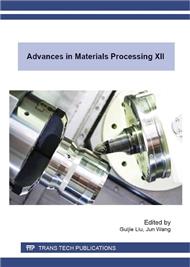p.26
p.32
p.38
p.44
p.50
p.56
p.63
p.69
p.75
Finite Element Simulation of Minimum Cutting Thickness in Micro-Cutting
Abstract:
The cutting edge radius and cutting thickness as well as feed rate are in the same order of magnitude in micro-cutting. So it will appear a situation that the chip cannot be formed when the cutting thickness is less than a certain value which is the minimum cutting thickness. It is possible to find a method that can determine the minimum cutting thickness in the finite element simulation of micro-cutting according. In this paper, a series of finite element simulations of different workpiece materials in micro-cutting are carried out and several different minimum cutting thicknesses are obtained. It is shown that the minimum cutting thickness is related to the workpiece material in micro-cutting. When the workpiece materials are different, the minimum cutting thicknesses obtained are also different in micro-cutting.
Info:
Periodical:
Pages:
50-55
Citation:
Online since:
July 2016
Authors:
Price:
Сopyright:
© 2016 Trans Tech Publications Ltd. All Rights Reserved
Share:
Citation:


